.
12.08.2014

NASA's Pluto-bound probe sees its distant TARGET
.
Heading toward a speedy encounter next summer, NASA's New Horizons spacecraft has glimpsed Pluto and its moon Charon in a cosmic orbital dance from a distance of more than 260 million miles.
.
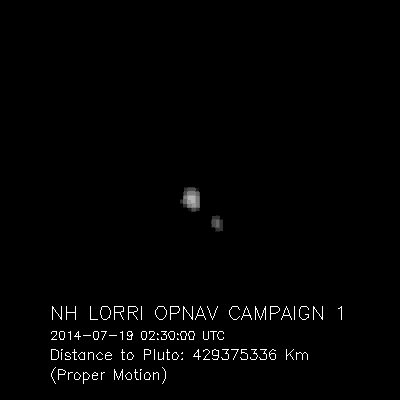
NASA/Johns Hopkins University Applied Physics Laboratory/Southwest Research Institute
.
Recorded over five days in July, the images show Charon completing one orbit of Pluto. Charon orbits approximately 11,200 miles from Pluto.
Pluto's smaller moons -- Nix, Hydra, Styx and Kerberos -- are too faint to see with the camera on New Horizons. Scientists say they will come into view as the probe nears Pluto next year.
The Long Range Reconnaissance Imager, or LORRI, instrument on New Horizons took the pictures used in the short movie. Ground controllers commanded the spacecraft to take the images as part of the mission's first optical navigation campaign, which is used to ensure New Horizons flies at the correct distance from Pluto during a high-speed flyby on July 14, 2015.
The encounter of Pluto by New Horizons will give scientists their first close-up view of the distant world.
The probe's images of Pluto and its moons will become better than the best views possible with the Hubble Space Telescope early next year.
"The image sequence showing Charon revolving around Pluto set a record for close range imaging of Pluto -- they were taken from 10 times closer to the planet than the Earth is," said Alan Stern, New Horizons principal INVESTIGATORfrom the Southwest Research Institute in Boulder, Colo. "But we'll smash that record again and again, starting in January, as approach operations begin."
Launched in January 2006, New Horizons will cross the orbit of Neptune on Aug. 25, then enter the last in a series of deep space hibernations Aug. 29.
"We are really excited to see our target and its biggest satellite in motion from our own perch, less than a year from the historic encounter ahead!"
New Horizons will wake up in December before starting long range encounter operations Jan. 4.
Quelle: SN
.
.
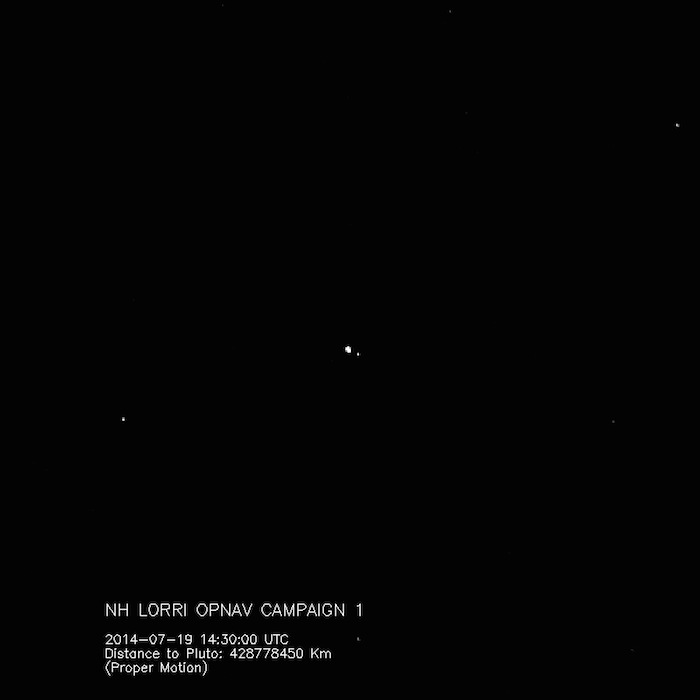
A still image from an animated GIF show New Horizon spacecraft's view of Charon orbiting Pluto in July 2014.
.
The New Horizons probe used its onboard TELESCOPE to record a video of Charon and Pluto locked in their orbital dance. The MOVIE is composed of 12 individual images taken from July 19 through July 24 — almost exactly one year before the spacecraft's flyby of the distant dwarf planet, which is scheduled for July 14, 2015.
"The image sequence showing Charon revolving around Pluto set a record for close-range imaging of Pluto — they were taken from 10 times closer to the planet than the Earth is," New Horizons principal INVESTIGATOR Alan Stern, of the Southwest Research Institute in Boulder, Colorado, said in a statement. "But we'll smash that record again and again, starting in January, as approach operations begin."
"We are really excited to see our target and its biggest SATELLITE in motion from our own perch, less than a year from the historic encounter ahead!" he added.
New Horizons was about 265 million miles (426 million kilometers) from Pluto when it took the 12 photos, researchers said.
.
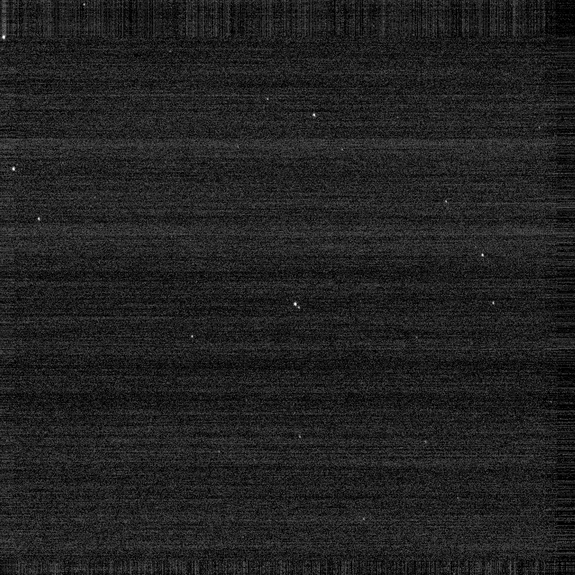
New Horizons spacecraft viewed dwarf planet Pluto and its large moon Charon (about 10,500 miles or 17,000 km. APART) with its LORRI camera, at a distance of over 249 million miles (400 million km.). Image released July 24, 2014.
.
At 750 miles (1,200 km) across, Charon is by far the largest of Pluto's five known moons; in fact, it's more than half as wide as Pluto itself. Charon orbits just 11,200 miles (18,000 km) above the dwarf planet's surface. For comparison, Earth's moon lies an average of 239,000 miles (385,000 km) away from us.
Because of their close proximity, Pluto and Charon orbit a central gravity point, known as a barycenter, that is located between the two BINARYobjects. The new video released by the New Horizons science team is centered on that barycentric point.
The New Horizons team released the new video late last week, just a few days after other spectacular Pluto and Charon imagery from the ALMA radio observatory in Chile CAME out.
ALMA, whose name is short for Atacama Large Millimeter/submillimeter Array, took the photos to help guide New Horizons' journey to the Pluto system, which lies about 40 times farther from the sun than Earth does.
.

ALMA radio observatory in Chile OBSERVED Pluto and its largest moon, Charon, on July 15, 2014.
.
ALMA's observations are helping pinpoint Pluto's position and path around the sun, which to this day are imperfectly known, researchers said. The knowledge gap isn't terribly surprising, considering the dwarf planet has been observed for just one-third of an orbit TO DATE. (Pluto takes 248 years to complete one lap around the sun and was just discovered in 1930.)
The ALMA team first observed Pluto and Charon in November 2013, then did so again once in April 2014 and twice this past July. More OBSERVATIONS are planned for October, researchers said.
New Horizons is about to get a deep-space break. The probe's handlers plan to put it into hibernation on Aug. 29, just four days after New Horizons crosses the orbit of Neptune. They'll wake the spacecraft on Dec. 6 to get ready for the flyby, researchers said.
Quelle: SC
.
Update: 25.08.2014
.
On to Pluto! NASA Spacecraft Now Beyond Neptune's Orbit (Photos)
A speedy NASA probe has crossed the orbit of Neptune, notching one more spaceflight milestone on its way toward a historic flyby of Pluto next summer.
New Horizons — which is scheduled to zoom through the Pluto system on July 14, 2015 — passed Neptune's orbit today (Aug. 25), 25 years to the day after NASA's Voyager 2 probe executed the first-ever flyby of faraway Neptune and its icy moon Triton.
New Horizons team members took the opportunity provided by this spaceflight coincidence to pay tribute to Voyager 2, the only probe ever to visit the "ice giant" planets Uranus and Neptune.
.
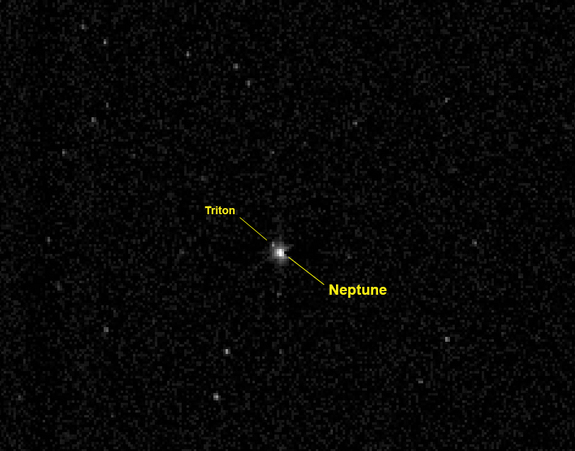
This labeled photo identifies the planet Neptune and its large moon Triton as they appeared to NASA's New Horizons spacecraft on July 10, 2014 from a distance of 2.45 billion miles (3.96 billion km). New Horizons is headed for a 2015 flyby of the dwarf planet Pluto. On Aug. 25, 2014, the probe passed the orbit of Neptune.
Credit: NASA/Johns Hopkins University Applied Physics Laboratory/Southwest Research Institute
.
"We stand on the shoulders of giants — giants like [Voyager project scientist] Ed Stone and his Voyager science team that pioneered how to do the exploration of the deep outer solar system," New Horizons principal investigator Alan Stern said during a news conference today, adding that the New Horizons team views the Voyager scientists and engineers as mentors.
As it neared the Neptune orbit crossing last month, the piano-size New Horizons probe even took a photo of the big blue planet and Triton, which were nearly 2.5 billion miles (4 billion kilometers) away at the time.
"They're so far away they're only points of light," Stern said of the photo, which was taken July 10 but publicly released today. "We don't see the kinds of detail to make the discoveries that Voyager could. That's the power of going close."
"We were surprised to find such an active atmosphere so far from the sun," Stone said today.
Stern expects many surprises when New Horizons reaches Pluto, partly because so little is known about the dwarf planet. It's so dim and far away that the best photos by NASA's powerful Hubble Space Telescope show Pluto as a blur of pixels.
"Everything that we know about the Pluto system today could probably fit on one piece of paper," Stern said.
New Horizons will use its seven science instruments to lift the veil on Pluto. The spacecraft will map the dwarf planet and its five known moons, determine the composition of Pluto's surface and atmosphere, search for undiscovered moons and a ring system and do many other things, Stern said.
"It's going to be a bonanza for science in so many ways," he said. "This is just mouth-watering."
Indeed, New Horizons' Pluto encounter will mark the first up-close reconnaissance of a previously unstudied world since Voyager 2 flew by Neptune a quarter-century ago, Stern added.
In the past two decades or so, scientists have come to realize that Pluto is just one of many dwarf planets that orbit the sun in the Kuiper Belt, a repository of icy bodies beyond Neptune's orbit. So learning about Pluto could also shed light on the other denizens of this dim and distant realm, Stern said.
New Horizons rocketed away from Earth at 36,000 mph (58,000 km/h) shortly after its January 2006 liftoff, making it the fastest spacecraft ever launched. The probe is now about 2.75 billion miles (4.43 billion km) from Earth and just 273 million miles (440 million km) from Pluto, NASA officials said.
Mission team members hope to send New Horizons on to visit another Kuiper Belt object after the Pluto flyby; they have been looking for other possible targets using Hubble.
Voyager 2 launched in August 1977, a few weeks before its twin, Voyager 1. Together, the two probes pulled off an ambitious "grand tour" of the solar system's biggest planets, giving scientists some of their first good looks at the Saturn, Jupiter, Uranus and Neptune systems.
After wrapping up this work, the Voyagers kept right on flying. Voyager 1 entered interstellar space in August 2012, and Voyager 2, which took a different route through the solar system, should get there soon as well.
.
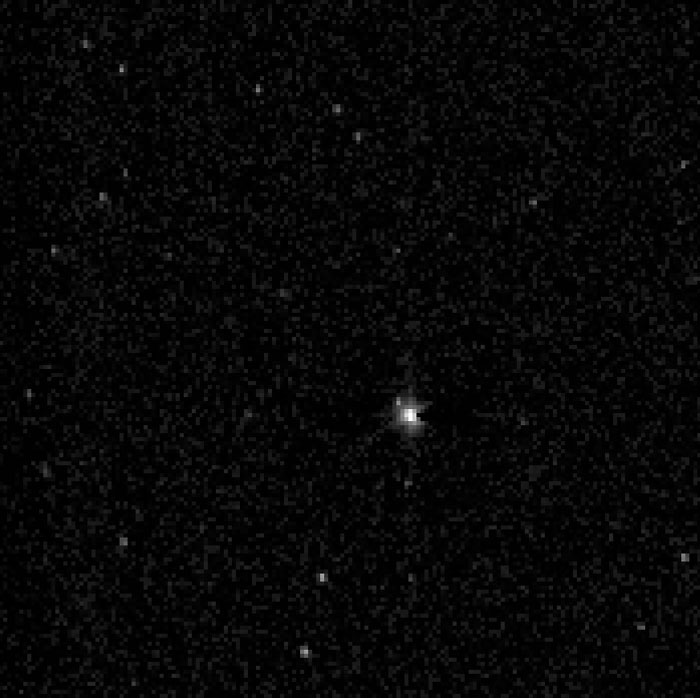
On it's way to Pluto, NASA's New Horizons spacecraft captured a view of Neptune and its large moon Triton on July 10, 2014, from roughly 2.45 billion miles (3.96 billion kilometers) away.
Credit: NASA/Johns Hopkins University Applied Physics Laboratory/Southwest Research Institute
Quelle: SC
.
Update: 13.09.2014
.
New Horizons Makes its First Detection of Pluto’s Moon Hydra
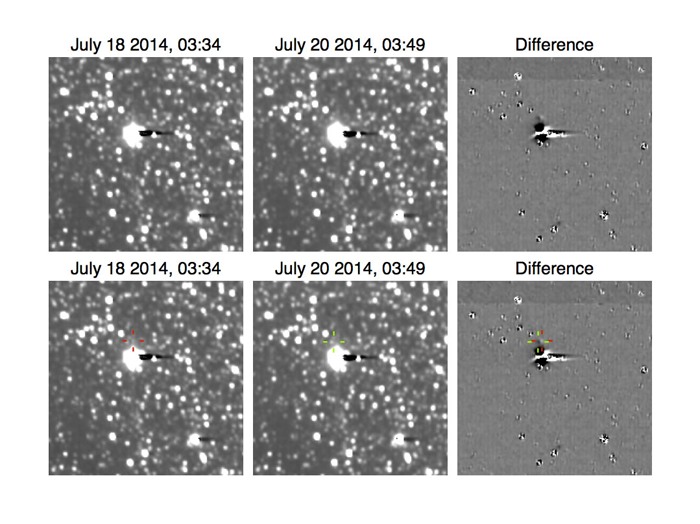
Using its Long Range Reconnaissance Imager (LORRI), New Horizons made its first detection of Pluto's small, faint, outermost known moon, Hydra. The images were taken to practice the long-exposure mosaics that the New Horizons team will use to search for additional moons and potentially hazardous debris near Pluto as the spacecraft approaches the Pluto system in May and June 2015.
Analysis of those images in September by Science Team members John Spencer, of the Southwest Research Institute, and Hal Weaver, of the Johns Hopkins Applied Physics Laboratory, revealed Hydra —a moon the mission didn’t expect to detect until next January, when New Horizons will be about twice as close as it was in July.
To detect Hydra, New Horizons took 48, 10-second images of Pluto on July 18 and again on July 20; the team combined half of them (which offered the best views of Hydra) to produce the very sensitive images on the dates shown. Pluto is the bright overexposed blob near the center of the image – the dark streak emerging to the right is a camera artifact caused by the intentional overexposure. The images on the two dates appear almost identical, but the difference between them is shown on the right. This “difference” image removes the crowded background of stars that doesn’t change between images. Hydra, which has moved over the two days, is revealed as an overlapping pair of bright and dark spots just above Pluto. The bottom row shows the same images with Hydra's expected position on the two dates, identified in each image by the red and green crosshairs. Hydra's motion can just be seen at the expected location in the original images. Pluto's next-brightest small moon, Nix, is closer to Pluto and cannot yet be separated from Pluto's glare.
“I’m excited about this first detection of Hydra,” says Principal Investigator Alan Stern, of the Southwest Research Institute. “It came as a bit of a bonus from this summer’s spacecraft activities.”
The processing tools used to combine the images and look for moving targets are the same ones that the team will use to search for much smaller “new” moons when New Horizons is much closer to Pluto. New Horizons was still 267 million miles (430 million kilometers) from Pluto when the pictures were taken, and the fact that it can already see Hydra was an encouraging test of the team's ability to find faint moons on the final approach to Pluto.
“Using those techniques, Hydra popped right out of the data, though it's still very faint – several times fainter than the faintest objects the New Horizons camera was designed to detect – and still very close to Pluto,” Spencer says. “We're thrilled to see it, because it shows that our satellite-search techniques work, and that our camera is operating superbly. But it's also exciting just to see a third member of the Pluto system come into view, as proof that we're almost there!”
.
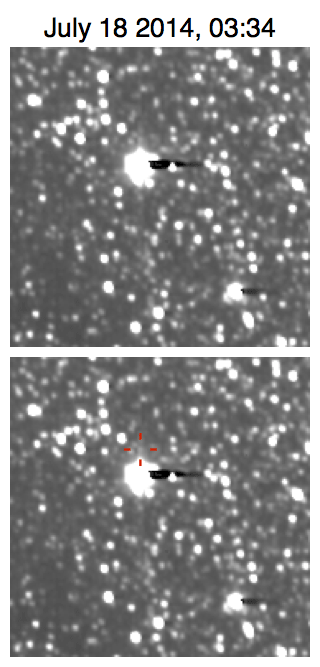
Image credit: NASA/Johns Hopkins University Applied Physics Laboratory/Southwest Research Institute
Quelle: NASA
.
Update: 16.11.2014
.
New Horizons Set to Wake Up for Pluto Encounter
NASA’s New Horizons spacecraft comes out of hibernation for the last time on Dec. 6. Between now and then, while the Pluto-bound probe enjoys three more weeks of electronic slumber, work on Earth is well under way to prepare the spacecraft for a six-month encounter with the dwarf planet that begins in January.
“New Horizons is healthy and cruising quietly through deep space – nearly three billion miles from home – but its rest is nearly over,” says Alice Bowman, New Horizons mission operations manager at the Johns Hopkins University Applied Physics Laboratory (APL) in Laurel, Md. “It’s time for New Horizons to wake up, get to work, and start making history.”
Since launching in January 2006, New Horizons has spent 1,873 days in hibernation – about two-thirds of its flight time – spread over 18 separate hibernation periods from mid-2007 to late 2014 that ranged from 36 days to 202 days long.
In hibernation mode much of the spacecraft is unpowered; the onboard flight computer monitors system health and broadcasts a weekly beacon-status tone back to Earth. On average, operators woke New Horizons just over twice each year to check out critical systems, calibrate instruments, gather science data, rehearse Pluto-encounter activities and perform course corrections when necessary.
New Horizons pioneered routine cruise-flight hibernation for NASA. Not only has hibernation reduced wear and tear on the spacecraft’s electronics, it lowered operations costs and freed up NASA Deep Space Network tracking and communication resources for other missions.
Ready to Go
New Horizons team members will give an overview of pre-Pluto preparations, as well as the science plans for the Pluto encounter, on Thursday, Nov. 13, at the American Astronomical Society Division for Planetary Sciences (DPS) meeting in Tucson, Ariz. The 90-minute briefing starts at noon (MST) and will be posted shortly afterward on the DPS meeting site.
Next month’s wake-up call was preprogrammed into New Horizons’ on-board computer in August, commanding it come out of hibernation at 3 p.m. EST on Dec. 6. About 90 minutes later New Horizons will transmit word to Earth that it’s in “active” mode; those signals, even traveling at light speed, will need four hours and 25 minutes to reach home. Confirmation should reach the mission operations team at APL around 9:30 p.m. EST. At the time New Horizons will be more than 2.9 billion miles from Earth, and just 162 million miles – less than twice the distance between Earth and the sun – from Pluto.
After several days of collecting navigation-tracking data, downloading and analyzing the cruise science and spacecraft housekeeping data stored on New Horizons’ digital recorders, the mission team will begin activities that include conducting final tests on the spacecraft’s science instruments and operating systems, and building and testing the computer-command sequences that will guide New Horizons through its flight to and reconnaissance of the Pluto system. Tops on the mission’s science list are characterizing the global geology and topography of Pluto and its large moon Charon, mapping their surface compositions and temperatures, examining Pluto’s atmospheric composition and structure, studying Pluto’s smaller moons and searching for new moons and rings.
New Horizons’ seven-instrument science payload, developed under direction of Southwest Research Institute, includes advanced imaging infrared and ultraviolet spectrometers, a compact multicolor camera, a high-resolution telescopic camera, two powerful particle spectrometers, a space-dust detector (designed and built by students at the University of Colorado) and two radio science experiments. The entire spacecraft, drawing electricity from a single radioisotope thermoelectric generator, operates on less power than a pair of 100-watt light bulbs.
Distant observations of the Pluto system begin Jan. 15 and will continue until late July 2015; closest approach to Pluto is July 14.
“We’ve worked years to prepare for this moment,” says Mark Holdridge, New Horizons encounter mission manager at APL. “New Horizons might have spent most of its cruise time across nearly three billion miles of space sleeping, but our team has done anything but, conducting a flawless flight past Jupiter just a year after launch, putting the spacecraft through annual workouts, plotting out each step of the Pluto flyby and even practicing the entire Pluto encounter on the spacecraft. We are ready to go.”
“The final hibernation wake up Dec. 6 signifies the end of an historic cruise across the entirety of our planetary system,” added New Horizons Principal Investigator Alan Stern, of the Southwest Research Institute. “We are almost on Pluto’s doorstep!”
The Johns Hopkins Applied Physics Laboratory manages the New Horizons mission for NASA’s Science Mission Directorate. Alan Stern, of the Southwest Research Institute (SwRI) is the principal investigator and leads the mission; SwRI leads the science team, payload operations, and encounter science planning. New Horizons is part of the New Frontiers Program managed by NASA's Marshall Space Flight Center in Huntsville, Ala. APL designed, built and operates the New Horizons spacecraft.
.
Pluto’s Exotic Chemistry
Reggie Hudson
NASA Research Scientist
My connection to Pluto and Charon is quite different from that of other scientists who write for the New Horizons website. Certainly I’m excited about the chance to visit and study objects in the outermost of our solar system’s three major regions. Who wouldn’t be? There can only be one first encounter and we’re now about to experience it, with all the suspense and surprises that it will entail. It will be a scientific-historical event that present and future generations will remember as our first encounter with the ancient worlds of the Kuiper Belt.
All that said, my own New Horizons experience will be colored by my background as a laboratory physical chemist. Imagine the Earth's nitrogen-dominated atmosphere moved about 30 times farther from the Sun than where you are right now. At that distance, the temperature is so low (-380 °F, -229 °C, 44 K) that the nitrogen gas, and other components of the atmosphere, would freeze into solid form, and that’s what we see on Pluto. We also know that two carbon-containing materials are present with Pluto’s frozen nitrogen, namely methane (CH4) and carbon monoxide (CO). And intriguingly, Pluto's surface has been bombarded with cosmic rays, high-energy radiation, for over four billion years, which will alter the surface’s composition and appearance in ways we can barely discern with even our most powerful telescopes.
So that’s what New Horizons will encounter next year, a world with a surface dominated by solid nitrogen, carbon compounds, and radiation-chemical products unlike any planet yet visited – and I’ll be ready. For more than 20 years I’ve worked in NASA laboratories studying various molecular ices to understand how radiation drives their evolution in Pluto's cold environment. Our experiments have given us some interesting answers and hints, and observational astronomers have given us others. However, the 2015 New Horizons encounter will deliver revolutionary insights into Pluto’s exotic chemistry – and I’ve not even mentioned the mysteries that await on Pluto’s equally exciting moon Charon!
.
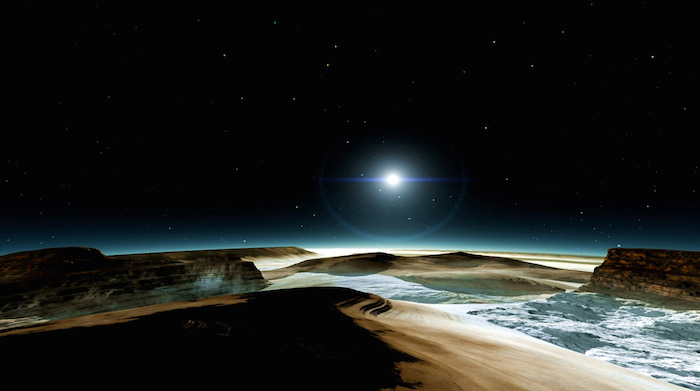
In Pluto – depicted in this artist’s impression – New Horizons will encounter a world with a surface dominated by solid nitrogen, carbon compounds, and radiation-chemical products unlike any planet yet visited.
(Image credit: NASA/Johns Hopkins University Applied Physics Laboratory/Southwest Research Institute/Steve Gribben)
Reggie Hudson is a research scientist and associate chief of the Astrochemistry Laboratory at NASA Goddard Space Flight Center in Greenbelt, Md. His research consists of the study of low-temperature chemistry, including the action of ionizing radiation on planetary and interstellar objects. He has received a NASA grant to investigate Pluto-Charon ice chemistry in collaboration with New Horizons co-investigator Will Grundy.
Quelle: NASA
.
Update: 18.11.2014
.
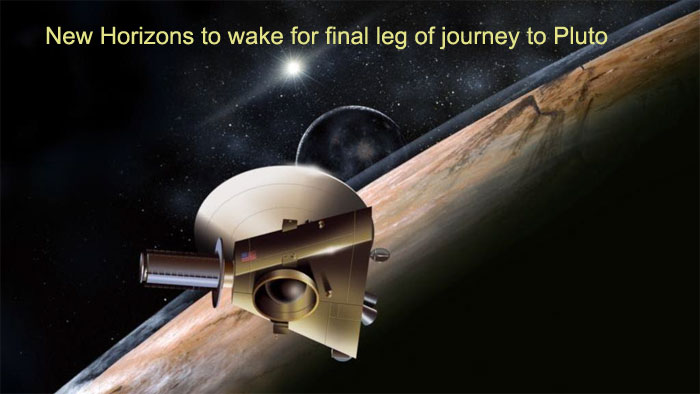
Just as ESA's Philae lander has begun sleeping on comet 67P/Churyumov–Gerasimenko, another space probe is getting ready to wake up. NASA’s New Horizons Pluto-bound spacecraft will come out of hibernation for the last time next month. The wake-up call was preprogrammed into New Horizons’ on-board computer in August, commanding it come out of hibernation at 3pm EST on 6 December. About 90 minutes later New Horizons will transmit word to Earth that it is in “active” mode; those signals, even traveling at light speed, will need four hours and 25 minutes to reach home. At the time New Horizons will be more than 2.9 billion miles from Earth, and just 162 million miles—less than twice the distance between Earth and the Sun—from Pluto. While the the probe enjoys three more weeks of electronic slumber, work on Earth is well under way to prepare the spacecraft for a six-month encounter with the dwarf planet that begins in January. “New Horizons is healthy and cruising quietly through deep space—nearly three billion miles from home—but its rest is nearly over,” said Alice Bowman, New Horizons mission operations manager at the Johns Hopkins University Applied Physics Laboratory (APL). “It’s time for New Horizons to wake up, get to work, and start making history.” Launched in January 2006, New Horizons has spent 1,873 days in hibernation, 66 per cent of its journey, spread over 18 separate hibernation periods from mid-2007 to late 2014 that ranged from 36 days to 202 days long. New Horizons has pioneered routine cruise-flight hibernation for NASA. Hibernation reduces wear and tear on the spacecraft’s electronics, lowers operations costs and frees up NASA Deep Space Network tracking and communication resources for other missions. On average, operators woke New Horizons just over twice each year to check out critical systems, calibrate instruments, gather science data, rehearse Pluto-encounter activities and perform course corrections when necessary. In hibernation mode the onboard flight computer monitors system health and broadcasts a weekly beacon-status tone back to Earth while the rest of the space craft remains unpowered.Once the probe awakes the mission team will conduct final tests on the spacecraft’s science instruments and operating systems, and build and test the computer-command sequences to guide New Horizons through its flight to and reconnaissance of the Pluto system. Distant observations of the Pluto system begin on 15 January and continue until late July 2015. Closest approach to Pluto will be on 14 July. “We’ve worked years to prepare for this moment,” said Mark Holdridge, New Horizons encounter mission manager at APL. “New Horizons might have spent most of its cruise time across nearly three billion miles of space sleeping, but our team has done anything but, conducting a flawless flight past Jupiter just a year after launch, putting the spacecraft through annual workouts, plotting out each step of the Pluto flyby and even practising the entire Pluto encounter on the spacecraft. We are ready to go.” New Horizons Principal Investigator Alan Stern, of the Southwest Research Institute, said: “The final hibernation wake up 6 December signifies the end of an historic cruise across the entirety of our planetary system. We are almost on Pluto’s doorstep!”
Quelle: SEN
.
Update: 1.12.2014
.
Boden-Team bereit, Pluto-Sonde für historischen Vorbeiflug zu wecken
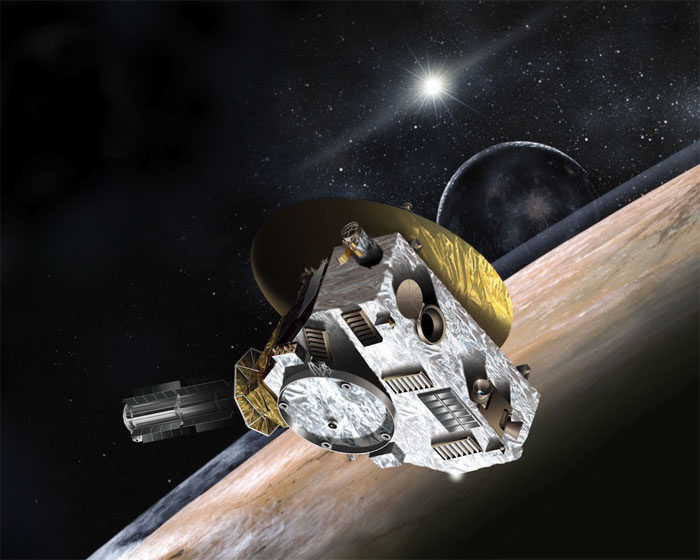
On the final stretch of a speedy nine-year trek through the solar system, NASA’s New Horizons spacecraft will be awakened from hibernation Dec. 6 for an encounter with Pluto, a mysterious world that has captured imaginations and will soon be revealed in reality.
The plutonium-powered probe — roughly the size and shape of a grand piano — is heading for a flyby 6,200 miles from Pluto’s icy, unexplored surface on July 14, 2015.
But scientists plan months of increasingly detailed observations of Pluto before then, beginning in January with long-range imaging to help navigators keep New Horizons on course for the make-or-break encounter.
“We’re at the very tail end of this very long cruise across almost 3 billion miles of our journey from the Earth to the Pluto system,” said Alan Stern, principal investigator on the New Horizons mission from the Southwest Research Institute in Boulder, Colo. “On Dec. 6, we’ll wake New Horizons up from its last hibernation and we will be on the doorstep of the Pluto system. Encounter starts just a few weeks later on Jan. 15.”
New Horizons launched aboard an Atlas 5 rocket on Jan. 19, 2006. The craft left Earth at record speed and reached Jupiter in February 2007 to pick up even more velocity, using the giant planet’s immense gravity field to slingshot toward Pluto.
The $700 million mission is the first to visit a halo of dark, icy worlds loitering outside the orbit of Neptune. Known as the Kuiper belt, the ring includes Pluto and thousands more objects which remain mostly undiscovered.
Stern touts New Horizons as the last in a wave of “first reconnaissance” missions dispatched from Earth since the 1960s to explore the planets.
The mission, Stern said, “is going to be truly historic, not in rewriting the textbook, but in writing the textbook about the Pluto system and Kuiper belt.”
“This is really quite an epic journey,” Stern said. “Three billion miles across the entirety of our planetary system, from the inner planets to the middle solar system to the third zone — the Kuiper belt — and for the first time. No voyage like this has been conducted since the epic days of Voyager, and nothing like it is planned again.”
Ground controllers put New Horizons to sleep intermittently through the probe’s nine-year cruise. The hibernations save time, Bowman said, allowing scientists to focus on planning the mission’s future scientific endeavors instead of tracking its flight through the void of space.
Computer commands already installed on the spacecraft will automatically wake up New Horizons on Dec. 6, then it will take more than four hours for radio signals from the probe to reach Earth at light speed.
Officials at the New Horizons control center at the Johns Hopkins University Applied Physics Laboratory in Maryland should receive confirmation of the spacecraft’s wakeup around 9:30 p.m. EST on Saturday (0230 GMT Sunday), according to Alice Bowman, mission operations manager at APL.
Engineers plan around six weeks of activities — memory checks, instrument calibrations, navigation updates — to prepare New Horizons for the official start of its encounter phase in January.
“All this is being done to prepare for the big show, which begins Jan. 15, 2015,” Bowman said.
Seven instruments on New Horizons will take pictures and measure everything from the composition of Pluto and its moons, to the nature of Pluto’s atmosphere, to how Pluto is influenced by the sun, which appears 900 times dimmer than the sun seen from Earth.
“We begin the observatory phase in January, and it continues until about April,” Stern said. “By May, we will be delivering imagery that’s better than Hubble, and it just gets better every week from there on in until we storm the gates of Pluto on Bastille Day, July 14, 2015.”
Quelle: SN
.
Update: 4.12.2014
.
CU-Boulder instrument on New Horizons readies for encounter with Pluto, Kuiper Belt
When NASA’s napping New Horizon’s spacecraft awakens later this week in preparation for its July 2015 encounter with Pluto, a University of Colorado Boulder student instrument onboard already will have been up for years.
The instrument, the Student Dust Counter (SDC), was designed and built to detect dust both on the interplanetary journey to Pluto and beyond, said CU-Boulder physics Professor Mihaly Horanyi, principal investigator on the effort. The SDC has been on for most of the mission -- even as the other instruments primarily napped -- measuring dust grains that are the building blocks of the solar system’s planets, he said.
Launched in 2006, the New Horizons mission was designed to help planetary scientists better understand the icy world at the edge of our solar system, including the dwarf planet Pluto and thousands of objects beyond it in the Kuiper Belt. The spacecraft, about the size of a grand piano, carries six other instruments.
The principal investigator for NASA’s New Horizons mission is Alan Stern of the Southwest Research Institute (SwRI) in Boulder, a CU-Boulder alumnus. SDC is the first student-built instrument ever to fly on a NASA planetary mission and holds the record for the most distant, functioning dust detector ever flown in space.
Beginning in 2002, more than 20 CU-Boulder undergraduate and graduate students began work to design and build the SDC, said Horanyi of the Laboratory for Atmospheric and Space Physics (LASP). The team changed in the early years as students graduated and moved on and dropped in size after the instrument was finally finished and integrated on the spacecraft. There are presently two graduate students involved with SDC, Jamey Szalay and Marcus Piquette.
The SDC is a thin plastic film resting on a honeycombed aluminum structure the size of a cake pan mounted on the outside of the spacecraft. A small electronic box inside the spacecraft functions as the instrument's "brain" to assess each individual dust particle that strikes the detector. The microscopic-sized dust grains hitting the SDC create unique electrical signals, allowing the students to infer the mass of each particle.
While the SDC has encountered and charted thousands of dust particles on its journey so far, the CU-Boulder researchers are particularly interested in sampling the Kuiper Belt. A vast region beyond Neptune's orbit thought to span more than a billion miles, the Kuiper Belt is believed to harbor at least 70,000 objects more than 60 miles in diameter, each containing samples of ancient material created during the solar system’s violent formation some 4.5 billion years ago.
“Ever since launch we have been flying through the disc of the solar solar system, learning about its structure and how planets push dust around,” said Szalay, a doctoral student in physics and a LASP researcher. “It’s going to be very exciting to get into the Kuiper Belt and see what we find there.”
Scientists will use the New Horizons spacecraft to characterize the geology and topography of Pluto and its large moon, Charon, including mapping their surfaces and temperatures, charting Pluto's atmosphere and structure, studying its smaller moons and searching for new moons and rings. The spacecraft is programmed to come of “hibernation” mode on Saturday.
“After the encounter with Pluto, we are planning to have a big party,” said Horanyi. “We will invite all of the students who worked on the SDC project at CU-Boulder over the years. It should be fun.”
Funding for SDC came primarily through the Johns Hopkins University Applied Physics Laboratory, which manages New Horizons, and SwRI. LASP also has contributed funds to help pay students working on SDC.
Quelle: University of Colorado Boulder
.
Update: 6.12.2014
.
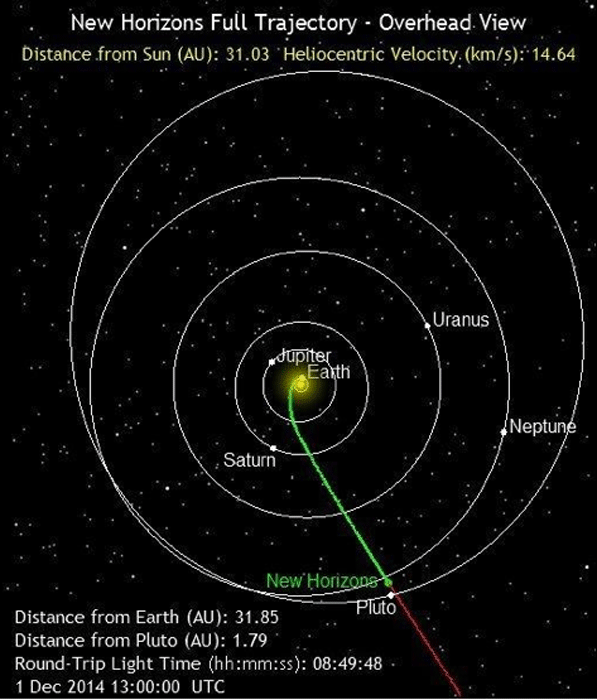
.
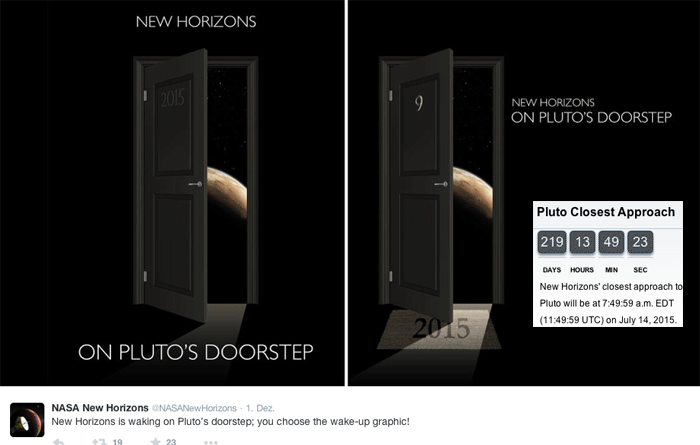
.
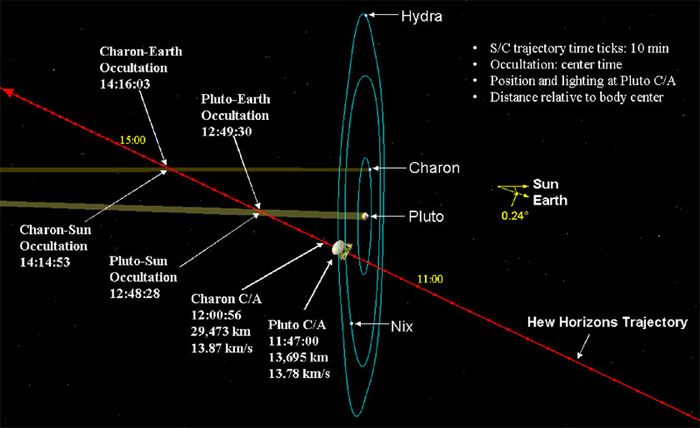
Quelle: NASA
.
Update: 7.12.2014
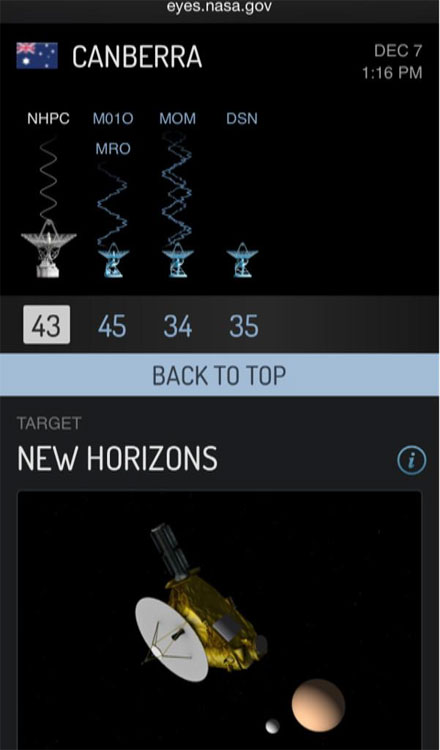
CanberraDSN @CanberraDSN · 5 Std. Vor 5 Stunden
#DSS43 now tracking @NewHorizons2015 @NASANewHorizons #wakeup #Pluto
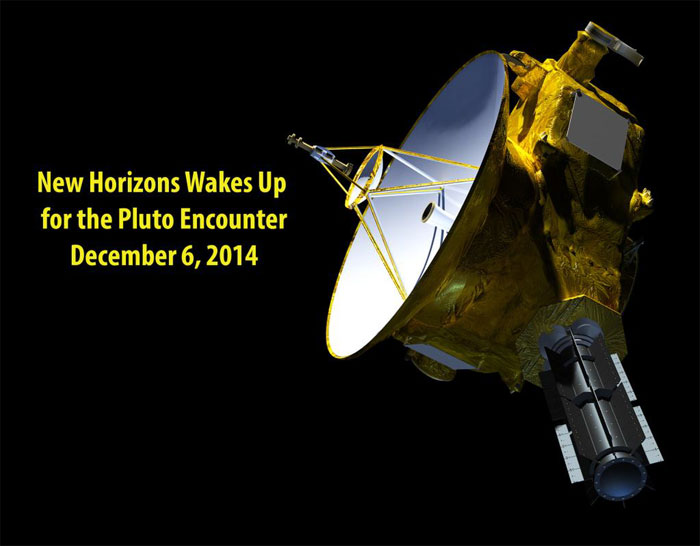
It's ALIVE! The @NASANewHorizons mission control just received full confirmation at 9:53 p.m ET! Pluto get ready!
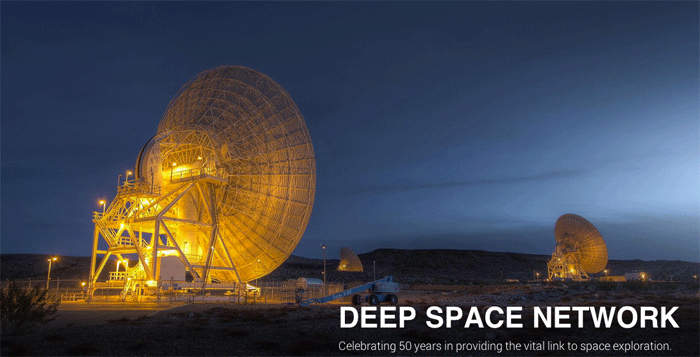
Quelle: NASA
.
Update: 20.45 MEZ
.
On Pluto's Doorstep, NASA's New Horizons Spacecraft Awakens for Encounter
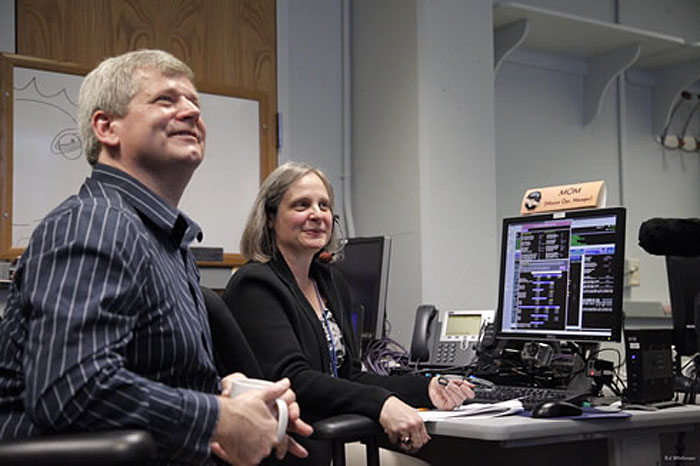
In the New Horizons Mission Operations Center at the Johns Hopkins Applied Physics Laboratory in Laurel, Md., New Horizons Mission Operations Manager Alice Bowman and operations team member Karl Whittenburg watch the screens for data confirming that the New Horizons spacecraft had transitioned from hibernation to active mode on Dec. 6.
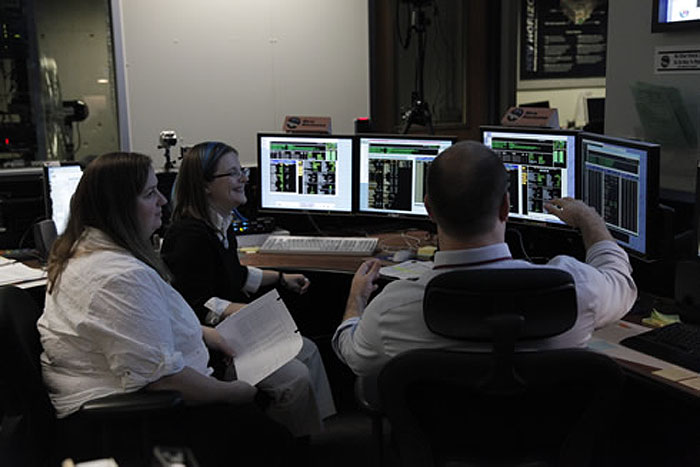
New Horizons flight controllers monitor data confirming that the Pluto-bound spacecraft had exited hibernation.
.
After a voyage of nearly nine years and three billion miles – the farthest any space mission has ever traveled to reach its primary target – NASA’s New Horizons spacecraft came out of hibernation today for its long-awaited 2015 encounter with the Pluto system.
Operators at the Johns Hopkins University Applied Physics Laboratory in Laurel, Md., confirmed at 9:53 p.m. (EST) that New Horizons, operating on pre-programmed computer commands, had switched from hibernation to “active” mode. Moving at light speed, the radio signal from New Horizons – currently more than 2.9 billion miles from Earth, and just over 162 million miles from Pluto – needed four hours and 26 minutes to reach NASA’s Deep Space Network station in Canberra, Australia.“This is a watershed event that signals the end of New Horizons crossing of a vast ocean of space to the very frontier of our solar system, and the beginning of the mission’s primary objective: the exploration of Pluto and its many moons in 2015,” said Alan Stern, New Horizons principal investigator from Southwest Research Institute, Boulder, Colo.
Since launching on January 19, 2006, New Horizons has spent 1,873 days — about two-thirds of its flight time — in hibernation. Its 18 separate hibernation periods, from mid-2007 to late 2014, ranged from 36 days to 202 days in length. The team used hibernation to save wear and tear on spacecraft components and reduce the risk of system failures.
“Technically, this was routine, since the wake-up was a procedure that we’d done many times before,” said Glen Fountain, New Horizons project manager at APL. “Symbolically, however, this is a big deal. It means the start of our pre-encounter operations.”
The wake-up sequence had been programmed into New Horizons' onboard computer in August, and started aboard the spacecraft at 3 p.m. EST on Dec. 6. About 90 minutes later, New Horizons began transmitting word to Earth on its condition, including the report that it is back in "active" mode.
Since launching on January 19, 2006, New Horizons has spent 1,873 days — about two-thirds of its flight time — in hibernation. Its 18 separate hibernation periods, from mid-2007 to late 2014, ranged from 36 days to 202 days in length. The team used hibernation to save wear and tear on spacecraft components and reduce the risk of system failures.
“Technically, this was routine, since the wake-up was a procedure that we’d done many times before,” said Glen Fountain, New Horizons project manager at APL. “Symbolically, however, this is a big deal. It means the start of our pre-encounter operations.”
The wake-up sequence had been programmed into New Horizons' onboard computer in August, and started aboard the spacecraft at 3 p.m. EST on Dec. 6. About 90 minutes later, New Horizons began transmitting word to Earth on its condition, including the report that it is back in "active" mode.
The New Horizons team will spend the next several weeks checking out the spacecraft, making sure its systems and science instruments are operating properly. They’ll also continue to build and test the computer-command sequences that will guide New Horizons through its flight to and reconnaissance of the Pluto system.
With a seven-instrument science payload that includes advanced imaging infrared and ultraviolet spectrometers, a compact multicolor camera, a high-resolution telescopic camera, two powerful particle spectrometers and a space-dust detector, New Horizons will begin observing the Pluto system on Jan. 15.
New Horizons’ closest approach to Pluto will occur on July 14, but plenty of highlights are expected before then, including, by mid-May, views of the Pluto system better than what the mighty Hubble Space Telescope can provide of the dwarf planet and its moons.
“New Horizons is on a journey to a new class of planets we’ve never seen, in a place we’ve never been before,” says New Horizons Project Scientist Hal Weaver, of APL. “For decades we thought Pluto was this odd little body on the planetary outskirts; now we know it’s really a gateway to an entire region of new worlds in the Kuiper Belt, and New Horizons is going to provide the first close-up look at them.”
The Johns Hopkins Applied Physics Laboratory manages the New Horizons mission for NASA’s Science Mission Directorate. Alan Stern, of the Southwest Research Institute (SwRI) is the principal investigator and leads the mission; SwRI leads the science team, payload operations, and encounter science planning. New Horizons is part of the New Frontiers Program managed by NASA's Marshall Space Flight Center in Huntsville, Ala. APL designed, built and operates the New Horizons spacecraft.
Quelle: NASA
.
Update: 16.01.2015
.
NASA’s New Horizons Spacecraft Begins First Stages of Pluto Encounter
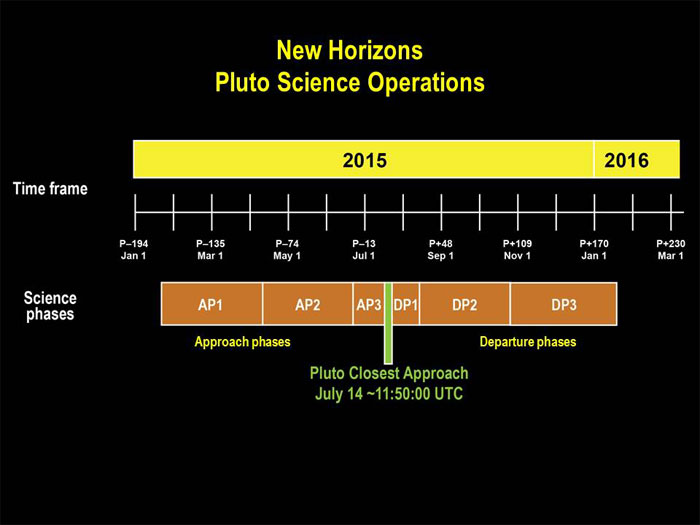
Timeline of the approach and departure phases — surrounding close approach on July 14, 2015 — of the New Horizons Pluto encounter.
.
NASA's New Horizons spacecraft recently began its long-awaited, historic encounter with Pluto. The spacecraft is entering the first of several approach phases that culminate July 14 with the first close-up flyby of the dwarf planet, 4.67 billion miles (7.5 billion kilometers) from Earth.
“NASA first mission to distant Pluto will also be humankind’s first close up view of this cold, unexplored world in our solar system,” said Jim Green, director of NASA’s Planetary Science Division at the agency’s Headquarters in Washington. “The New Horizons team worked very hard to prepare for this first phase, and they did it flawlessly.”
The fastest spacecraft when it was launched, New Horizons lifted off in January 2006. It awoke from its final hibernation period last month after a voyage of more than 3 billion miles, and will soon pass close to Pluto, inside the orbits of its five known moons.
In preparation for the close encounter, the mission’s science, engineering and spacecraft operations teams configured the piano-sized probe for distant observations of the Pluto system that start Sunday, Jan. 25 with a long-range photo shoot.
The images captured by New Horizons’ telescopic Long-Range Reconnaissance Imager (LORRI) will give mission scientists a continually improving look at the dynamics of Pluto’s moons. The images also will play a critical role in navigating the spacecraft as it covers the remaining 135 million miles (220 million kilometers) to Pluto.
“We’ve completed the longest journey any spacecraft has flown from Earth to reach its primary target, and we are ready to begin exploring,” said Alan Stern, New Horizons principal investigator from Southwest Research Institute in Boulder, Colorado.
LORRI will take hundreds of pictures of Pluto over the next few months to refine current estimates of the distance between the spacecraft and the dwarf planet. Though the Pluto system will resemble little more than bright dots in the camera’s view until May, mission navigators will use the data to design course-correction maneuvers to aim the spacecraft toward its target point this summer. The first such maneuver could occur as early as March.
“We need to refine our knowledge of where Pluto will be when New Horizons flies past it,” said Mark Holdridge, New Horizons encounter mission manager at Johns Hopkins University’s Applied Physics Laboratory (APL) in Laurel, Maryland. “The flyby timing also has to be exact, because the computer commands that will orient the spacecraft and point the science instruments are based on precisely knowing the time we pass Pluto – which these images will help us determine.”
The “optical navigation” campaign that begins this month marks the first time pictures from New Horizons will be used to help pinpoint Pluto’s location.
Throughout the first approach phase, which runs until spring, New Horizons will conduct a significant amount of additional science. Spacecraft instruments will gather continuous data on the interplanetary environment where the planetary system orbits, including measurements of the high-energy particles streaming from the sun and dust-particle concentrations in the inner reaches of the Kuiper Belt. In addition to Pluto, this area, the unexplored outer region of the solar system, potentially includes thousands of similar icy, rocky small planets.
More intensive studies of Pluto begin in the spring, when the cameras and spectrometers aboard New Horizons will be able to provide image resolutions higher than the most powerful telescopes on Earth. Eventually, the spacecraft will obtain images good enough to map Pluto and its moons more accurately than achieved by previous planetary reconnaissance missions.
APL manages the New Horizons mission for NASA’s Science Mission Directorate in Washington. Alan Stern, of the Southwest Research Institute (SwRI), headquartered in San Antonio, is the principal investigator and leads the mission. SwRI leads the science team, payload operations, and encounter science planning. New Horizons is part of the New Frontiers Program managed by NASA's Marshall Space Flight Center in Huntsville, Alabama. APL designed, built and operates the spacecraft.
Quelle: NASA
.
Update: 18.01.2015
.
Wo ist New Horizons
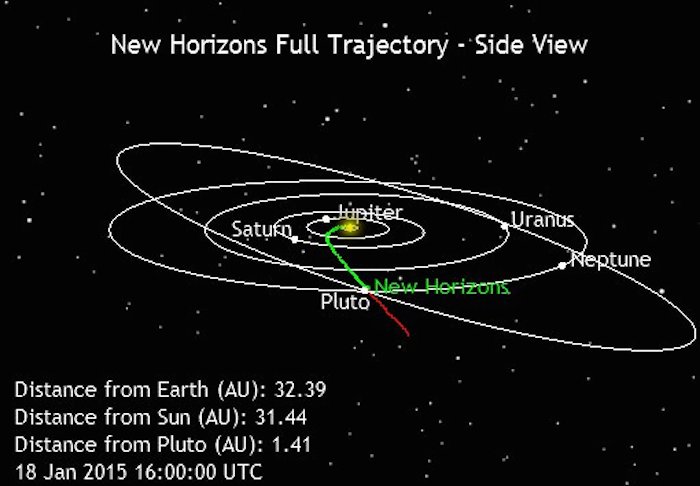
.
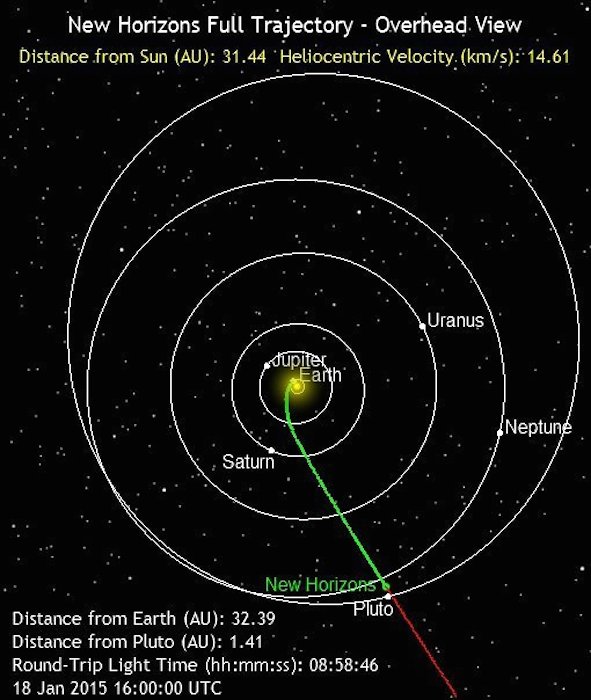
.
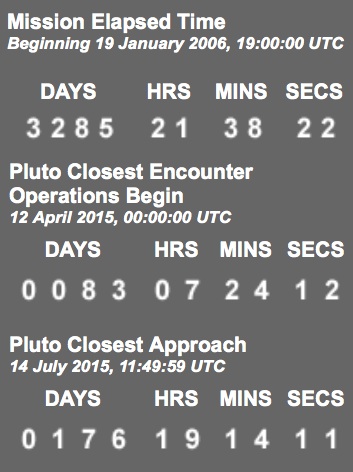
Quelle: NASA
-
Update: 24.01.2015
-
The PI's Perspective
Something Special in the Air
The earliest stages of our Pluto encounter have begun, and New Horizons remains healthy and on course.
Already, the SWAP, PEPSSI and SDC instruments are taking daily science data — measuring the charged particle and dust environment of the space near Pluto’s orbit. Next week, on Jan. 25, the sensitive LORRI long focal length camera aboard New Horizons will begin imaging the Pluto system for navigation purposes. This will yield dozens of images that our navigation teams will analyze for positional information about Pluto and Charon against star fields, allowing us to home in more accurately than by radio navigation from Earth alone.
But while New Horizons approaches the Pluto system ever more closely, there is a little time left to write about what’s in store, so let’s begin.
In this update, I’m going to preview the atmospheric science we’ll do during the flyby. Next time, I’ll preview the surface geology and composition measurements we’re planning.
But first I want to give you the basics of what we know about Pluto’s atmosphere, and Charon’s.
Pluto’s atmosphere is composed primarily of nitrogen, just like Earth’s atmosphere. But its minor gases aren’t oxygen and argon – as on Earth – they are carbon monoxide and methane; other gases may also be present. Pluto’s atmospheric pressure is about the same as that in the Earth’s mesosphere, about 30 to 50 miles above the ground. Its atmosphere is known to display a mild greenhouse effect, as well as winds and, very likely, some hazes. There may even be clouds.
We also know that Pluto’s atmosphere is rapidly escaping, much like the way the early Earth’s atmosphere escaped, in a process called hydrodynamic escape. This happens when molecules high in the atmosphere are hot enough to simply flow away, a little like a cup of water filled up from the bottom and brimming over the rim.
As for Charon: it’s been speculated that this world, Pluto’s largest moon may, have an atmosphere. Perhaps it was captured (siphoned) off Pluto or created by internal activity or a recent cometary impact. But whatever (if anything) is there, it’s been too thin to find from Earth. New Horizons will attempt to do better.
Our objectives for atmospheric science during the flyby match the recommendations from the scientific advisory committees that worked with NASA to conceive a Pluto flyby mission; they include:
Determine how Pluto’s atmospheric pressure and temperature vary from the surface to high altitude.
Determine the atmosphere’s complete composition.
Measure the atmospheric escape rate.
Determine if Pluto has an ionosphere.
Determine how Pluto’s atmosphere varies from place to place, and with seasons and time of day.
Search for an atmosphere at Charon.
That’s a long and ambitious list of objectives, and we’re carrying a very capable suite of scientific instruments to probe all of these questions. Here’s a brief preview of the atmospheric science we’re planning for later this year, organized by instrument:
REX is our radio science experiment. On closest-approach day — July 14 — REX will intercept a set of four 20-kilowatt beams of radio energy sent to Pluto by giant 70-meter-wide antennas in NASA’s Deep Space Network. By measuring how these radio beams refract (or bend) through Pluto’s atmosphere, REX can help us determine the base pressure and temperature of Pluto’s atmosphere, as well as how those quantities vary with altitude above Pluto’s surface. REX can also determine another atmospheric quantity: the density of ionospheric layers high over Pluto.
Alice is our ultraviolet spectrometer. Many of the gases in Pluto’s atmosphere reveal themselves best at ultraviolet wavelengths. We’ll be using Alice over several weeks as we approach Pluto to search for emissions that reveal certain atomic gases like hydrogen, oxygen, nitrogen and argon in Pluto’s upper atmosphere. Then, on encounter day, we’ll fly into Pluto’s shadow and watch the Sun rise and set with Alice to determine the composition of the atoms and molecules in Pluto’s atmosphere as a function of height over the surface. We’ll also perform the same experiment at Charon to determine of it has a thin atmosphere and what that envelope may be made of. (REX will try to do the same, but it’s not as sensitive as Alice for detecting atmospheres as thin as Charon’s is likely to be.)
-
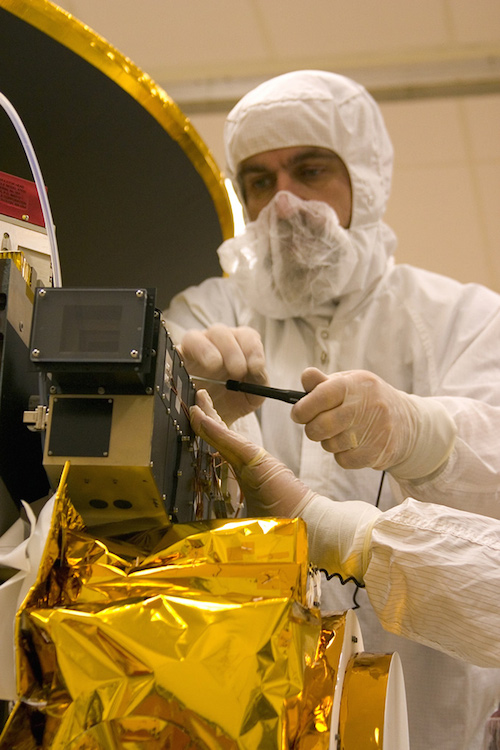
The Alice ultraviolet spectrometer aboard New Horizons. (Image: NASA/JHUAPL)
.
PEPSSI, which stands for Pluto Energetic Particle Spectrometer Science Investigation, measures high-energy ions that originate in Pluto’s atmosphere and accelerate as they stream away in the solar wind. PEPSSI will determine the composition as well as the densities of these ions; this will help us pin down Pluto’s atmospheric composition and escape rate.
SWAP, for Solar Wind Around Pluto, performs a clever measurement of Pluto’s total atmospheric escape rate. How? At some distance from Pluto, the atmospheric escape pressure balances with the incoming solar wind pressure – and the distance at which this occurs from Pluto reveals the rate of Pluto’s atmospheric escape. SWAP’s job is to accurately measure that distance by determining where the solar wind cuts off and Pluto’s atmosphere begins.
LORRI (our Long Range Reconnaissance Imager) and Ralph are primarily surface imagers – not atmospheric instruments – but they can shed light on Pluto’s atmosphere by searching for clouds and hazes, both as New Horizons approaches and recedes. In fact, LORRI and Ralph could, in principle, make the first atmospheric detections of Pluto by New Horizons by capturing images of just such phenomena, perhaps even weeks before REX, Alice, PEPSSI and SWAP conduct their investigations.
As you can see, we have a wide variety of ways to plumb Pluto’s atmosphere and search for one around Charon. The fun begins in May, and intensifies across June and July.
Stay tuned – soon I won’t be talking about plans, I’ll be able to write about results!
.
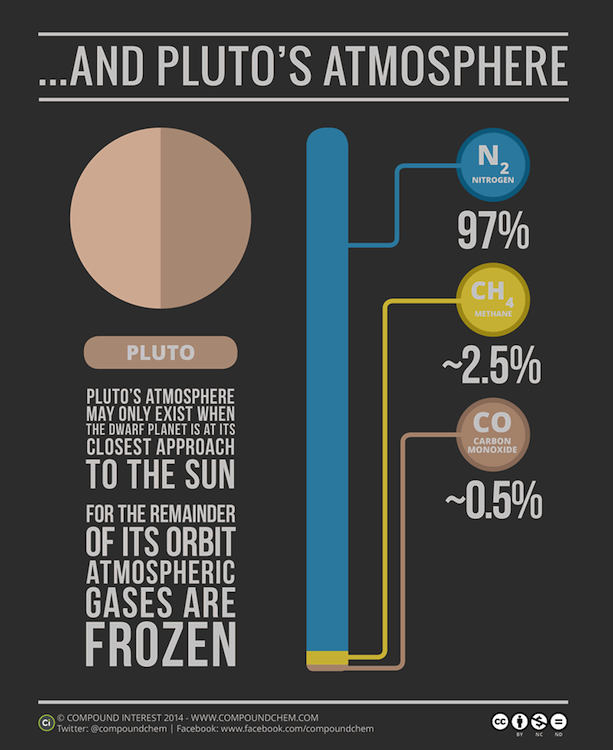
Like Earth’s atmosphere, Pluto’s atmosphere is dominated by nitrogen gas. (Image: Compound Interest,
-
As I close, I know you know that this is our last January before reaching our long-sought objective of reconnoitering Pluto and its system of moons. But what you may not know is that January is a very special month for the New Horizons team: We launched in January, our science team meets to plan ahead every January, and January is also when Clyde Tombaugh took the images of Sagittarius that initiated his discovery of Pluto. So hail to January, and also to this July when our explorations culminate — just around the bend!
That’s it for now, but until I write again, I hope you’ll keep exploring—just as we do.
Quelle: NASA
-
Update: 5.02.2015
.
Happy Birthday Clyde Tombaugh: New Horizons Returns New Images of Pluto
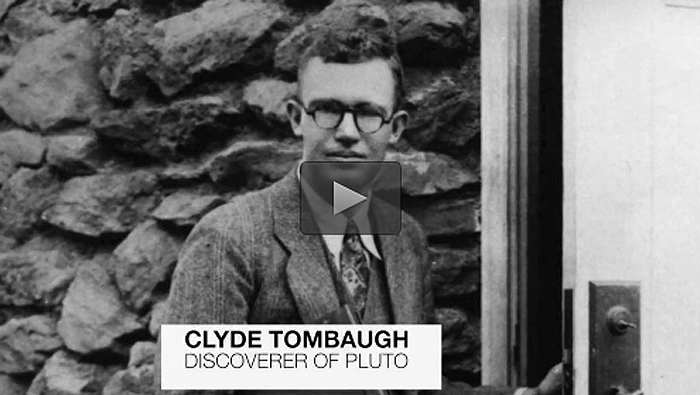
Pluto discoverer Clyde Tombaugh could only dream of a spacecraft flying past the small planet he spotted on the edges of the solar system in 1930. Yet the newest views of Pluto from NASA's approaching New Horizons probe – released today, on the late American astronomer's birthday – hint at just how close that dream is to coming true.
Tombaugh, who died in 1997, was born on Feb. 4, 1906.
"This is our birthday tribute to Professor Tombaugh and the Tombaugh family, in honor of his discovery and life achievements — which truly became a harbinger of 21st century planetary astronomy," said New Horizons Principal Investigator Alan Stern, from the Southwest Research Institute, Boulder, Colorado. "These images of Pluto, clearly brighter and closer than those New Horizons took last July from twice as far away, represent our first steps at turning the pinpoint of light Clyde saw in the telescopes at Lowell Observatory 85 years ago, into a planet before the eyes of the world this summer."
The new images, taken with New Horizons' telescopic Long-Range Reconnaissance Imager (LORRI) on Jan. 25 and Jan. 27, were the first acquired during the spacecraft's 2015 approach to the Pluto system, which culminates with a close flyby of Pluto and its system of moons on July 14. New Horizons was more than 126 million miles (203 million kilometers) away from Pluto when it began taking the photos, which show Pluto and largest moon, Charon."Pluto is finally becoming more than just a pinpoint of light," said Hal Weaver, New Horizons project scientist at the Johns Hopkins University Applied Physics Laboratory (APL) in Laurel, Maryland. "LORRI has now resolved Pluto, and the dwarf planet will continue to grow larger and larger in the images as New Horizons spacecraft hurtles toward its targets. The new LORRI images also demonstrate that the camera's performance is unchanged since it was launched more than nine years ago."
-
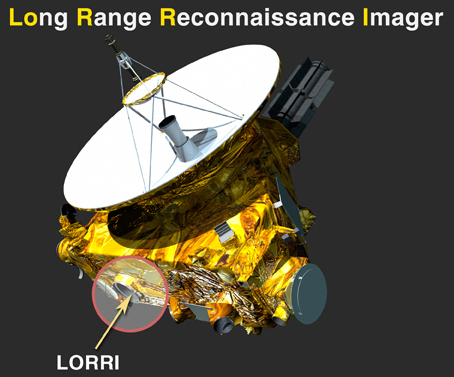
The "eagle eyes" of New Horizons, LORRI is a panchromatic high-magnification imager, consisting of a telescope with an 8.2-inch (20.8-centimeter) aperture that focuses visible light onto a charge-coupled device. It's essentially a digital camera with a large telephoto telescope – only fortified to operate in the cold, hostile environs near Pluto.
.
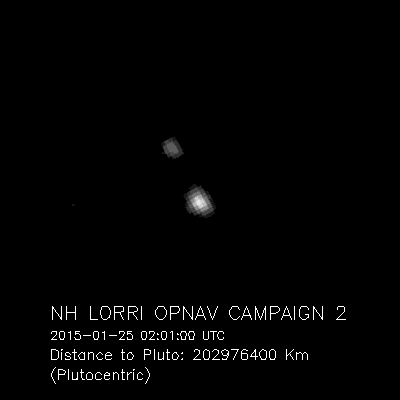
A Long Distance Look from LORRI:Pluto and Charon, the largest of Pluto's five known moons, seen Jan. 25 and 27, 2015, through the telescopic Long-Range Reconnaissance Imager (LORRI) on NASA's New Horizons spacecraft. New Horizons was about 126 million miles (203 million kilometers) from Pluto when the frames to make the first image were taken; about 1.5 million miles (2.5 million kilometers) closer for the second set. These images are the first acquired during the spacecraft's 2015 approach to the Pluto system, which culminates with a close flyby of Pluto and its m
6207 Views
